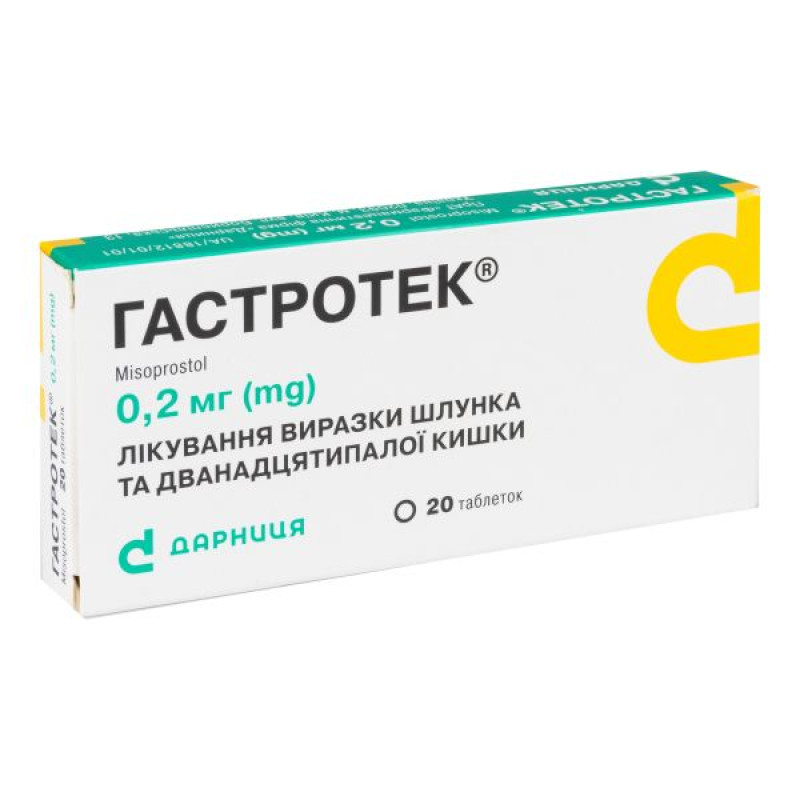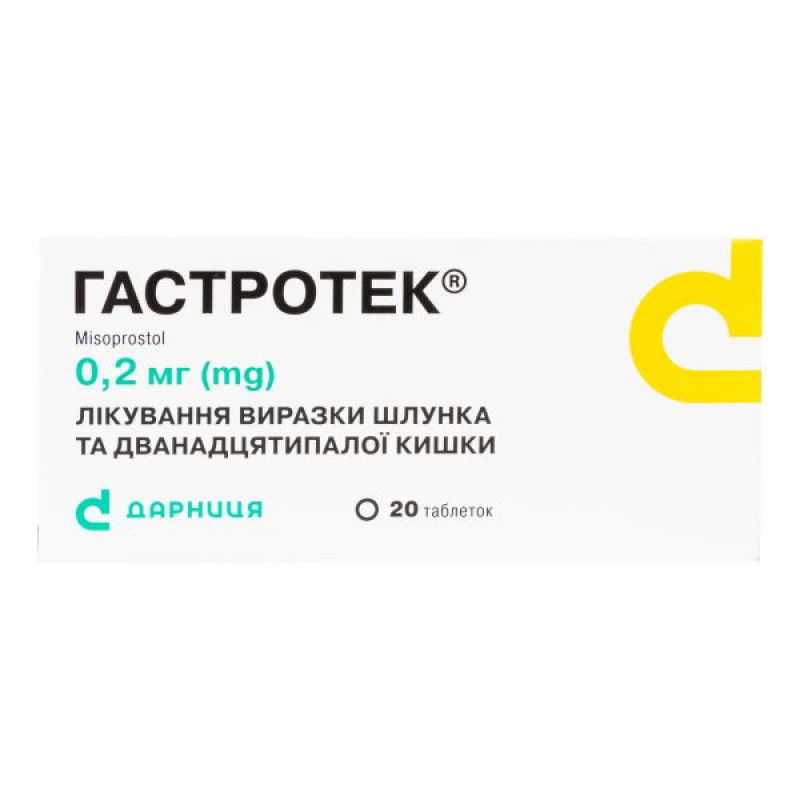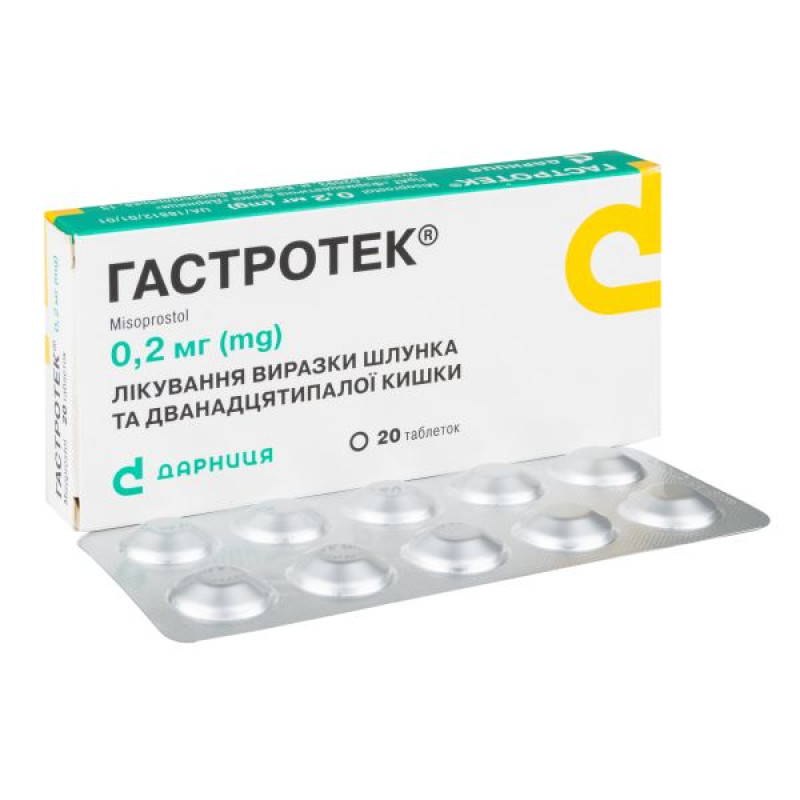Gastrotek tablets 0.2 mg No. 20

Instructions Gastrotek tablets 0.2 mg No. 20
Composition
active ingredient: misoprostol;
1 tablet contains misoprostol 0.2 mg as misoprostol dispersion (1:100 in hypromellose);
Excipients: microcrystalline cellulose, hydrogenated castor oil, sodium starch glycolate (type A), colloidal anhydrous silicon dioxide.
Dosage form
Pills.
Main physicochemical properties: tablets of white or almost white color with a yellowish-grayish tint, round flat-cylindrical shape, with a bevel.
Pharmacotherapeutic group
Prostaglandins. Misoprostol. ATX code A02B B01.
Pharmacological properties
Pharmacodynamics.
Gastrotek® is an analogue of natural prostaglandin E1, which promotes the healing of peptic ulcer disease and alleviates its symptoms. The drug protects the mucous membrane of the gastrointestinal tract (GI) by inhibiting basal, stimulated and nocturnal acid secretion, reducing the volume and proteolytic activity of gastric juice and increasing the secretion of bicarbonate in mucus.
Pharmacokinetics.
Gastrotec® is rapidly absorbed after oral administration. The maximum concentration (Cmax) of misoprostol acid, which is the active metabolite, is approximately 30 minutes. The half-life of misoprostol from blood plasma is 20-40 minutes. After repeated administration of 400 mcg 2 times a day, accumulation of misoprostol acid in blood plasma does not occur.
Indication
Treatment of gastric and duodenal ulcers, particularly those caused by the use of non-steroidal anti-inflammatory drugs (NSAIDs), in patients with arthritis who are at risk but continue NSAID therapy.
Prevention of ulcers caused by the use of NSAIDs.
Contraindication
Hypersensitivity to the active substance or to any of the other ingredients of the medicinal product; known allergy to prostaglandins.
Use in women of reproductive age who are not using effective contraception.
Pregnancy or use in women in whom pregnancy cannot be excluded or in women planning pregnancy, due to the fact that misoprostol increases uterine tone and contractions, which may lead to termination of pregnancy and partial or complete abortion. The use of misoprostol during pregnancy has been associated with fetal defects (see sections "Special instructions", "Use during pregnancy or breastfeeding", "Adverse reactions").
Interaction with other medicinal products and other types of interactions
Concomitant use of NSAIDs and misoprostol may in some cases cause increased transaminase levels and peripheral edema.
Misoprostol is primarily metabolized via fatty acid oxidation systems and does not exhibit any adverse effects on the hepatic microsomal mixed function oxidase (P450) enzyme system.
No clinically significant pharmacokinetic interaction with antipyrine or diazepam has been demonstrated in specific studies.
With repeated administration of misoprostol, a slight increase in propranolol concentrations was observed (on average approximately 20% in AUC and 30% in Cmax). Drug interaction studies with misoprostol and several NSAIDs did not demonstrate a clinically significant effect on the kinetics of ibuprofen, diclofenac, piroxicam, acetylsalicylic acid, naproxen or indomethacin.
Magnesium-containing antacids should be avoided during treatment with misoprostol, as this may increase misoprostol-induced diarrhea.
Application features
When prescribing the drug to women of reproductive age, it is necessary to exclude the possibility of pregnancy and use appropriate contraceptive measures. If pregnancy is detected, the drug should be discontinued immediately (see sections "Contraindications", "Use during pregnancy or breastfeeding", "Adverse reactions").
Such patients are recommended to take misoprostol only if they:
- use effective contraception;
- informed about the risk of misoprostol use during pregnancy (see section "Contraindications").
Gastrointestinal bleeding, ulceration and perforation have been reported in patients receiving NSAID therapy and misoprostol. In the presence of ulcers, even in the absence of gastrointestinal symptoms, treatment should be continued with caution and, if appropriate, endoscopy and biopsy should be performed before use to exclude upper gastrointestinal malignancy. These studies should be repeated at appropriate intervals for follow-up if necessary.
Symptomatic reactions to misoprostol do not exclude the presence of gastric malignancy.
Misoprostol should be used with caution in patients with conditions that may be associated with diarrhea, such as inflammatory bowel disease. To minimize the risk of diarrhea, misoprostol should be taken with food and magnesium-containing antacids should be avoided.
Experience with misoprostol at doses effective in promoting healing of gastric and duodenal ulcers suggests that the drug does not cause hypotension. However, misoprostol should be used with caution in the presence of morbid conditions, as hypotension may lead to serious complications, such as cerebrovascular disease, coronary artery disease, or severe peripheral vascular disease, including hypertension.
There is no evidence that misoprostol has a negative effect on glucose metabolism in patients with diabetes.
Important information about excipients
The medicine contains hydrogenated castor oil, which may cause stomach upset and diarrhea. Therefore, patients with inflammatory bowel diseases should use the medicine with extreme caution.
This medicinal product contains 14.4 mg/dose of sodium. Caution should be exercised when administering this medicinal product to patients on a controlled sodium diet.
Use during pregnancy or breastfeeding
Women of childbearing potential should be informed of the risk of teratogenicity before starting treatment. Treatment should not be initiated until pregnancy has been ruled out. The woman should be counseled about the importance of adequate contraception during treatment. If pregnancy is suspected, treatment should be discontinued immediately.
Pregnancy
Misoprostol is contraindicated in pregnant women because it induces uterine contractions and may lead to termination of pregnancy and partial or complete abortion, fetal death, or congenital malformations. Exposure to misoprostol during the first trimester of pregnancy is associated with a significant increase in the risk of congenital defects: Moebius sequences (e.g., paralysis of cranial nerves VI and VII), amniotic cord syndrome (deformities and shortening of limbs, especially clubfoot, acheria, oligodactyly, cleft palate), and central nervous system anomalies (cerebral and craniocerebral anomalies such as anencephaly, hydrocephalus, cerebellar hypoplasia, neural tube defects). Other defects have been observed, including arthrogryposis.
Therefore, women should be informed of the risk of teratogenicity. If the patient wishes to continue the pregnancy after in utero exposure to misoprostol, a careful ultrasound examination of the fetus should be performed, paying special attention to the extremities and head.
The risk of uterine rupture increases with increasing gestational age, if there is a history of previous uterine surgery, cesarean section. A large number of pregnancies in history is also a risk factor for uterine rupture.
Breastfeeding period
Misoprostol is rapidly metabolized to misoprostolic acid, which is a biologically active substance and passes into breast milk. Since misoprostol acid may cause undesirable effects, such as diarrhea, in breast-fed infants, the drug should not be used during breastfeeding.
Ability to influence reaction speed when driving vehicles or other mechanisms
Since misoprostol may cause dizziness, patients are advised to refrain from driving or operating machinery.
Method of administration and doses
Treatment of duodenal ulcers, gastric ulcers and peptic ulcers caused by NSAIDs: 800 mcg daily in two or four divided doses taken with breakfast and/or each main meal and at bedtime.
Treatment should be started for at least 4 weeks, even if symptomatic relief is achieved earlier. In most patients, ulcers heal within 4 weeks, but treatment may be continued for up to 8 weeks if necessary. If the ulcer recurs, an additional course of treatment may be prescribed.
Prophylaxis of NSAID-induced peptic ulceration: 200 mcg twice daily, three times daily, or four times daily. The dosage should be individualized for each patient and according to the clinical condition.
Renal impairment: Available data suggest that no dose adjustment is necessary for patients with renal impairment.
Hepatic impairment: Misoprostol is metabolized by fatty acid oxidation systems present throughout the body. Therefore, its metabolism and plasma levels are unlikely to be significantly affected in patients with hepatic impairment.
Elderly patients: the usual dose can be used.
Children.
There is no experience with the use of the drug in children.
Overdose
The toxic dose of misoprostol in humans has not been determined. Clinical signs that may indicate overdose include drowsiness, tremor, convulsions, shortness of breath, abdominal pain, diarrhea, fever, palpitations, hypotension, or bradycardia.
Symptomatic therapy is recommended.
Misoprostol at a dosage of 1200 mcg daily for three months has been reported to be used without significant adverse effects.
Side effects
All adverse reactions are listed by system organ class and frequency: very common (≥ 1/10), common (≥ 1/100 - < 1/10), uncommon (≥ 1/1000 - < 1/100), rare (≥ 1/10000 - < 1/1000), very rare (< 1/10,000), frequency unknown (cannot be estimated from the available data).
From the nervous system: often - dizziness, headache.
On the part of the immune system: frequency unknown - anaphylactic reactions.
Skin and subcutaneous tissue disorders: very common – rash.
From the reproductive system and mammary gland function: infrequently - vaginal bleeding (including postmenopausal bleeding), intermenstrual bleeding, menstrual cycle disorders, uterine muscle spasm; rarely - menorrhagia, dysmenorrhea; frequency unknown - uterine bleeding.
Pregnancy, puerperium and perinatal period: rare - uterine rupture**; frequency unknown - amniotic fluid embolism, abnormal uterine contractions, fetal death, incomplete abortion, premature birth, delayed placental abruption, uterine perforation.
Congenital, familial and genetic disorders: frequency unknown – fetal malformations.
General disorders: rarely - chills; infrequently - fever.
* Diarrhea and abdominal pain were dose-related and usually occurred early in the course of therapy and were localised. Rare cases of diarrhoea leading to severe dehydration have been reported. Diarrhoeal symptoms may be minimised by taking a dose of no more than 200 mcg with food and by avoiding magnesium-containing antacids.
** Uterine rupture has been reported uncommonly after prostaglandin administration during the second and third trimesters of pregnancy. Uterine rupture has occurred in women who have given birth multiple times or in women with a scar from a cesarean section.
The side effects that occur with misoprostol and NSAIDs are similar.
Over 15,000 patients in clinical trials have received at least one dose of misoprostol. Adverse reactions were predominantly gastrointestinal in nature. The profile of adverse reactions with an incidence of > 1% was similar in short-term (4–12 weeks) and long-term (up to 1 year) clinical trials. The safety of long-term (> 12 weeks) misoprostol has been demonstrated in several studies in which patients received continuous treatment for 1 year.
This does not include adverse or unusual changes in the morphology of the gastric mucosa determined after gastric biopsy. There were no significant differences in the safety profile of misoprostol in patients aged 65 years and older compared to younger patients. Misoprostol has not been evaluated in children.
Reporting of suspected adverse reactions
Reporting suspected adverse reactions after the marketing authorisation of a medicinal product is an important procedure. It allows for continued monitoring of the benefit-risk balance of the medicinal product in question. Healthcare professionals should report any suspected adverse reactions via the national reporting system.
Expiration date
2 years.
Storage conditions
Store in the original packaging at a temperature not exceeding 25 °C.
Keep out of reach of children.
Packaging
10 tablets in a blister; 2 blisters in a pack.
Vacation category
According to the recipe.
Producer
PrJSC "Pharmaceutical Company "Darnitsa".
Address
Ukraine, 02093, Kyiv, Boryspilska St., 13.
There are no reviews for this product.
There are no reviews for this product, be the first to leave your review.
No questions about this product, be the first and ask your question.









